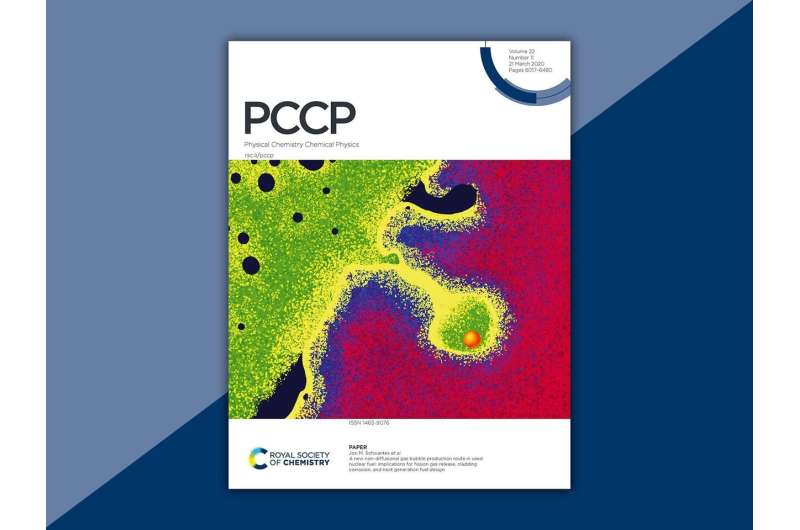Rad revelations: Future fuel designs from noble metals

Researchers at PNNL are removing a shroud of mystery surrounding the behavior of certain metal particles in nuclear fuel. The team's findings could improve future fuel designs for more efficient and safe production of nuclear energy.
In a recent experiment, researchers connected tellurium-containing particles in uranium dioxide fuel to the subsequent formation and rupture of high-pressure gas bubbles. Ruptures can damage the fuel and its protective outer layer known as cladding. The findings are detailed in a research paper featured on the cover of the March 21 edition of Physical Chemistry Chemical Physics.
The team's experiment was sponsored by PNNL's Nuclear Process Science Initiative (NPSI). The research is the latest in a series of NPSI-funded inquiries that have produced insights about noble metal phase (NMP) particle behavior in nuclear fuel during reactor operations.
A noble inquiry
Historically, tiny NMP particles found throughout used nuclear fuel were thought to consist of five metals: ruthenium, molybdenum, palladium, technetium, and rhodium. A few years ago, NPSI researchers revealed a sixth metal, tellurium.
A subsequent study also reported, for the first time, the finding of these particles within the fuel's zirconium cladding near the interface with the fuel. From this discovery, researchers hypothesized that rupturing gas bubbles were responsible for propelling the particles into the cladding.
"NPSI's work is dramatically adding to the body of information about noble metal phase particles," contends Jon Schwantes, a PNNL chemist. Schwantes leads NPSI's nuclear security research focus and is lead author for the recent journal paper, "A new non-diffusional gas bubble production route in used nuclear fuel: implications for fission gas release, cladding corrosion, and next generation fuel design."
From particle to gas bubble
To conduct the latest experiment, the team used a spent fuel sample irradiated in a commercial reactor during the period from 1979 to 1992. They employed various instruments in PNNL's Radiochemical Processing Laboratory to characterize the sample, including scanning and transmission electron microscopes, both equipped with energy dispersive X-ray spectroscopy.
The team also used the Oak Ridge Isotope Generation and Depletion Code computer program to simulate activation and decay of the tellurium isotopes within NMP particles over time. The researchers then compared these results to experimental measurements they had previously published.
In order to test the hypothesis of bubble rupture, the team used a simple physics continuum model borrowed from the ballistics community. The approach gave an indication of the energy and penetration of a particle when propelled out of the fuel and into the cladding after bubble rupture.
The team's work, augmented by the earlier NPSI studies, led to several key conclusions:
- In used fuel, tellurium and palladium are likely the first components to combine and precipitate, promoting the formation and growth of the other NMP particles.
- Within hours of formation, the tellurium atoms decay to stable xenon, eventually forming gas bubbles near the NMP particles.
- The xenon gas bubbles can reach extremely high pressures. Within the bulk of the fuel, uranium dioxide is strong enough to contain them.
- However, when bubbles form within 5 to 10 microns of the fuel surface, pressure within the bubble, combined with local effects from radiation damage (fission recoil), can catastrophically overpower the uranium oxide layer. The resulting bubble rupture propels nearby NMP particles out of the fuel and into the adjacent cladding surface.
"These results have far-reaching implications on the current understanding of the behavior of fission gas atoms within irradiated nuclear fuel," Schwantes says. "Our work has shed more light on issues of fuel integrity, fission gas release, and cladding corrosion, while informing the science driving next-generation high burnup fuel designs."
One more piece of the puzzle
The recent experiment adds to knowledge gained from the multiple NPSI-funded NMP particle inquiries since 2015. In addition to discovering tellurium as a sixth metal and finding particles in cladding, the team's earlier studies revealed:
- Tellurium distribution in fuel correlates with palladium.
- A palladium-rich telluride phase is likely the first component of the NMP to form during irradiation.
- NMP particles are closely associated with a number of other important fission products, including iodine, cesium, barium, and xenon. All of these elements have been discovered within the cladding near NMP.
These discoveries continue to enhance scientific understanding of NMP particles and their formation, fate, and importance within the nuclear fuel cycle.
More information: Jon M. Schwantes et al. A new non-diffusional gas bubble production route in used nuclear fuel: implications for fission gas release, cladding corrosion, and next generation fuel design, Physical Chemistry Chemical Physics (2020). DOI: 10.1039/C9CP05363H
Journal information: Physical Chemistry Chemical Physics
Provided by Pacific Northwest National Laboratory



















